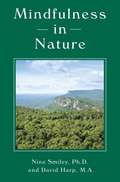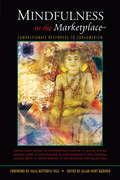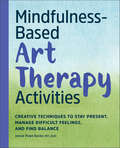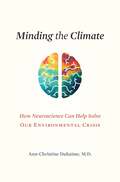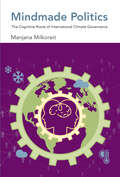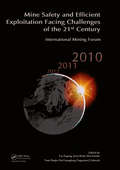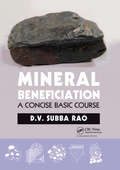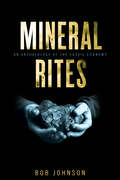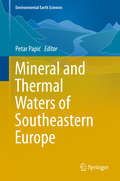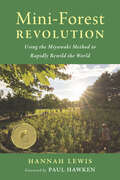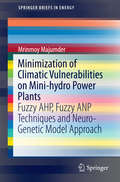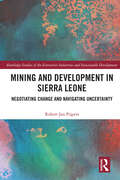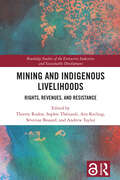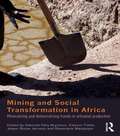- Table View
- List View
Mindfulness in Nature
by David Harp Nina SmileyMindfulness in Nature helps readers separate themselves from their busy lives, and allows them to engage in a deeper, more fulfilling relationship with the natural world around them through meditative practice.Now more than ever, with the constant distractions that abound in modern life—from smart phones to social media—it is imperative we seek the solace and comfort of nature for our well-being. The Japanese have a term for it: Shinrin-yoku or "Forest Bathing". Mindfulness experts Dr. Nina Smiley and David Harp have created a new guide called Mindfulness in Nature which provides a meaningful way to nurture ourselves through a sense of spaciousness, calm, and connection with the out-of-doors.Penned from the breathtaking natural setting of Mohonk Mountain House in New Paltz, New York, Mindfulness in Nature affords readers access to wisdom from dozens of notable authors, philosophers and poets – including Henry David Thoreau, Emily Dickinson, and Walt Whitman – on the important themes of nature, spirituality, simple beauty and joyful living. More than just a walk in the woods, Mindfulness in Nature is a carefully crafted and deliberate approach to achieve better health and well-being and is ideal for all ages.
Mindfulness in the Marketplace: Compassionate Responses to Consumerism
by Julia Hill Allan Hunt BadinerMindfulness in the Marketplace suggests a reorientation of consumers from passive purchasers to aware, responsible citizens who see the dynamic connection between their purchases and their values. The Middle Path of Buddhism is not to avoid all consumption, but to consume mindfully in a manner that protects ourselves and all living systems. This anthology outlines a path of compassionate resistance to global corporatization, and offers a view of getting into right relationship with the Earth. Includes the Dalai Lama, Thich Nhat Hanh, Stephen Batchelor, and Joanna Macy.
Mindfulness-Based Art Therapy Activities: Creative Techniques to Stay Present, Manage Difficult Feelings, and Find Balance
by Jennie Powe RundeDiscover the healing power of art Painting a seascape or sculpting a clay pot is more than just a fun way to spend an hour—it can also be therapeutic. Explore art's healing potential with this compelling art therapy activity book. You'll pair mindfulness with different creative projects, using self-expression and introspection as tools to work through difficult emotions, stressful situations, and self-doubt.Rooted in mindfulness—From drawing to digital photography, explore a variety of relaxing and beginner-friendly activities designed to help you improve your focus, awareness, and self-compassion.Dive into different art projectsFind deeper meaning in God's Word with thoughtful commentary that speaks to issues all married couples face, from establishing good communication to remaining faithful.Reflect on your work—Every project concludes with thoughtful prompts that encourage you to view your art through the lens of mindfulness and connect it to the present moment.Find serenity through self-expression with Mindfulness-Based Art Therapy Activities.
Minding the Climate: How Neuroscience Can Help Solve Our Environmental Crisis
by Ann-Christine DuhaimeA neurosurgeon explores how our tendency to prioritize short-term consumer pleasures spurs climate change, but also how the brain’s amazing capacity for flexibility can—and likely will—enable us to prioritize the long-term survival of humanity.Increasingly politicians, activists, media figures, and the public at large agree that climate change is an urgent problem. Yet that sense of urgency rarely translates into serious remedies. If we believe the climate crisis is real, why is it so difficult to change our behavior and our consumer tendencies?Minding the Climate investigates this problem in the neuroscience of decision-making. In particular, Ann-Christine Duhaime, MD, points to the evolution of the human brain during eons of resource scarcity. Understandably, the brain adapted to prioritize short-term survival over more uncertain long-term outcomes. But the resulting behavioral architecture is poorly suited to the present, when scarcity is a lesser concern and slow-moving, novel challenges like environmental issues present the greatest danger. Duhaime details how even our acknowledged best interests are thwarted by the brain’s reward system: if a behavior isn’t perceived as immediately beneficial, we probably won’t do it—never mind that we “know” we should. This is what happens when we lament climate change while indulging the short-term consumer satisfactions that ensure the disaster will continue.Luckily, we can sway our brains, and those of others, to alter our behaviors. Duhaime describes concrete, achievable interventions that have been shown to encourage our neurological circuits to embrace new rewards. Such small, incremental steps that individuals take, whether in their roles as consumers, in the workplace, or in leadership positions, are necessary to mitigate climate change. The more we understand how our tendencies can be overridden by our brain’s capacity to adapt, Duhaime argues, the more likely we are to have a future.
Minding the Earth, Mending the World: Zen and the Art of Planetary Crisis
by Susan MurphyShunryu Suzuki Roshi founded the San Francisco Zen Center in 1962, and after fifty years we have seen a fine group of Zen masters trained in the west take up the mantle and extend the practice of Zen in ways that might have been hard to imagine in those first early years. Susan Murphy, one of Robert Aitken's students and dharma heirs, is one of the finest in this group of young Zen teachers. She is also a fine writer, and following on the teaching of her Roshi she has engaged her spiritual work in the ordinary world, dealing with the practice of daily life and with the struggles of all beings.We know that our earth is in crisis, but is the situation beyond repair? Are we on a path of planetary disaster where the only proper response is to prepare for our melancholic dystopian future? Is there a way out of our suspicious cynicism?In the tradition of Thomas Berry, using this spiritual opportunity to change the very nature of our crisis, Susan Murphy offers a profound message, subtly presented with clarity and assurance, showing that engaged Buddhism provides a possible path to the necessary repair and healing.
Mindmade Politics: The Cognitive Roots of International Climate Governance (The\mit Press Ser.)
by Manjana MilkoreitHow integrating cognitive theories and international relations scholarship can yield valuable insights into the effectiveness of climate negotiations.Mindmade Politics takes a novel, interdisciplinary approach to understanding the complex and contentious dynamics of global climate politics. Manjana Milkoreit argues that integrating cognitive theories and international relations scholarship can yield valuable insights into multilateral cooperation (or the lack of it) on climate change and the process of negotiating climate agreements. Milkoreit argues that cognition is at the root of all political behavior and decision making. Some of the most important variables of international relations scholarship—the motivations of political actors—are essentially cognitive variables. Drawing on interviews with participants in the United Nations Framework Convention on Climate Change (UNFCCC), Milkoreit examines the thoughts, beliefs, and emotions of individuals and groups, focusing on the mental mechanisms connecting decision-relevant factors and observed political behavior. Milkoreit offers a brief introduction to international relations theory and key insights regarding the politics of climate change; outlines the basic cognitive theories and concepts that she applies in her analysis, discussing the cognitive challenges of climate change; and describes the integrated methodological approach she used for her cognitive-political analysis. She presents four cognitive-affective lessons for global change politics, including the “cognitive triangle” of three major concerns of climate negotiators—threat, identity, and justice—and she identifies six major belief systems driving negotiators. Finally, she offers guidance for climate governance based on her findings. Utilizing recent advances in cognitive science, Milkoreit builds a theoretical bridge between two major disciplines that will benefit both scholars and practitioners.
Mine Safety and Efficient Exploitation Facing Challenges of the 21st Century: International Mining Forum 2010
by Jerzy Kicki Eugeniusz J. Sobczyk Liu Zegong Hua Xinzhu Yuan Shujie Dai GuanglongThe International Mining Forum is a meeting of scientists and professionals for exchanging new ideas and experiences, evaluate previously implemented solutions, and discuss fresh ideas that might change the mining industry's image. In recent years theory and technology in mine safety and efficient exploitation has made considerable progress in Chin
Mineral Beneficiation: A Concise Basic Course
by D.V. Subba RaoMineral Beneficiation or ore dressing of run-of-mine ore is an upgrading process to achieve uniform quality, size and maximum tenor ore through the removal of less valuable material. Beneficiation benefits the costs of freight, handling, and extraction (smelting) reduce, and the loss of metal through slag. Usually carried out at the mine site, it s
Mineral Materials Modeling: A State-of-the-Art Review (Routledge Revivals)
by William A. VogelyOriginally published in 1976, this study was undertaken to fill a gap in knowledge about non-fuel resources and the advantages and disadvantages of specific methodologies of analysing material modelling. Mineral Materials Modeling examines the influence of factors such as raw material price and availability, technological aspects and related environmental questions in relation to both economic and mathematical models. The results are particularly helpful in terms of forecasting, policy development and decision-making about mineral materials as well as assessing the usefulness of different types of model. This title will be of interest to students of Environmental Studies as well as policy makers and professionals.
Mineral Rites: An Archaeology of the Fossil Economy (Energy Humanities)
by Bob JohnsonAn archaeology of Western energy culture that demystifies the role that fossil fuels play in the day-to-day rituals of modern life.Spanning the past two hundred years, this book offers an alternative history of modernity that restores to fossil fuels their central role in the growth of capitalism and modernity itself, including the emotional attachments and real injuries that they generate and command. Everything about us—our bodies, minds, sense of self, nature, reason, and faith—has been conditioned by a global infrastructure of carbon flows that saturates our habits, thoughts, and practices. And it is that deep energy infrastructure that provides material for the imagination and senses and even shapes our expectations about what it means to be fully human in the twenty-first century. In Mineral Rites, Bob Johnson illustrates that fossil fuels are embodied today not only in the morning commute and in home HVAC systems but in the everyday textures, rituals, architecture, and artifacts of modern life. In a series of illuminating essays touching on such disparate topics as hot yoga, electric robots, automobility, the RMS Titanic, reality TV, and the modern novel, Johnson takes the discussion of fossil fuels and their role in climate change far beyond the traditional domains of policy and economics into the deepest layers of the body, ideology, and psyche. An audacious revision to the history of modernity, Mineral Rites shows how fossil fuels operate at the level of infrapolitics and how they permeate life as second nature.
Mineral and Thermal Waters of Southeastern Europe
by Petar PapićThis book brings together the latest findings on mineral and thermal waters from countries in Southeastern (SE) Europe (Croatia, Bosnia and Herzegovina, Serbia, Montenegro, Macedonia, Albania, Romania and Bulgaria). Each chapter is dedicated to the most recent geochemical and hydrogeological investigations for a specific country in SE Europe, helping readers to understand the origins and applications of mineral and thermal waters - aspects which are of great importance for the economic development of this region, as these waters are renewable resources, and have been gaining in popularity over the last few decades. Thanks to the region's favorable geological conditions, it is home to more than 6,000 sources of mineral and thermal waters, characterized by different physical properties and chemical compositions.
Minerals and Allied Natural Resources and their Sustainable Development
by Sanjib Chandra Sarkar Mihir DebNonrenewable natural resources - metallic and non-metallic minerals, industrial rocks and energy resources (both organic and inorganic), have been treated in a holistic manner in this book, including two important resources (soil and water), not commonly covered in most books on this topic. For the uninitiated reader, an introductory chapter looks into some basic definitions as well as nature and characteristics of mineral deposits followed by a chapter on the different crustal processes that produce the various ore deposits in the endogenous and exogenous environments. The strength of the book lies in its critical treatment of the genetic processes of the mineral deposits, their classification and the geodynamic context of metallogeny, and coverage of sustainable development of mineral deposits with special reference to various socio-economic as well as regulatory and environmental issues that face the Indian mining industry today. The text is punctuated with examples of Indian deposits, balanced with classical deposits around the world, to cater to the interests of Indian students and the international readership. This is a book for advanced undergraduate and post-graduate students of Geology, Environmental Sciences and Natural Resource Management.
Mines of Clear Creek County
by Ben M. DuganIn 1859, "Pikes Peak or bust!" spread across America and brought men and their families from all over to the Kansas goldfields seeking a new beginning. Thousands came to Clear Creek and Gilpin Counties and eventually settled all of Colorado. The mining communities of Idaho Springs, Georgetown, Empire, Silver Plume, Dumont, and Lawson all exist because of the pursuit of gold and silver. Gold was initially easy to get to, but in time, underground mineral development was necessary. New technologies and the Industrial Revolution made mining easier, but there was still work to be done to establish local fire departments, churches, schools, and governments.
Ming Lo Moves the Mountain
by Arnold LobelMing Lo and his wife love their house, but not the mountain that overshadows it, so Ming Lo undertakes to move the mountain.
Mini Meadows: Grow a Little Patch of Colorful Flowers Anywhere around Your Yard
by Mike LizotteThe word “meadow” conjures images of wide expanses of land, but a mini meadow — a kind of informal flower garden started with seed sown directly into the soil — can be any size; plus, it’s fun, easy to grow, and good for the planet. With as little as 50 square feet and for less than $20, gardeners can plant a colorful meadow that demands little in the way of space, mowing, or maintenance, uses less water than a traditional lawn, and provides habitat for pollinators — not to mention a natural exploration space for children. From choosing the right variety of seeds, preparing the soil, sowing evenly, and watering well, author Mike Lizotte guides readers through the process of successfully creating a miniature meadow that suits their climate, soil, and growing goals, whether planting to beautify a hellstrip, halt erosion, fill a boggy spot, or establish a nesting area for bees and butterflies. Mini Meadows offers gardeners of all levels the keys to creating, caring for, and reaping the rewards of thriving meadows through the seasons, year after year. This publication conforms to the EPUB Accessibility specification at WCAG 2.0 Level AA.
Mini-Forest Revolution: Using the Miyawaki Method to Rapidly Rewild the World
by Hannah Lewis*2023 Nautilus Book Award Gold Medal Winner: Green, Restorative Practices /Sustainability&“Hannah Lewis describes a gift to a despairing world. . . . There may be no single climate solution that has a greater breadth of benefits than mini-forests. . . [and] can be done by everyone everywhere.&”—Paul Hawken, from the forewordFor readers who enjoyed Finding the Mother Tree and The Hidden Life of Trees comes the first-ever book about a movement to restore biodiversity in our cities and towns by transforming empty lots, backyards, and degraded land into mini-forests. Author Hannah Lewis is the forest maker turning asphalt into ecosystems to save the planet and she wants everyone to know they can do it too.In Mini-Forest Revolution, Lewis presents the Miyawaki Method, a unique approach to reforestation devised by Japanese botanist Akira Miyawaki. She explains how tiny forests as small as six parking spaces grow quickly and are much more biodiverse than those planted by conventional methods. She explores the science behind why Miyawaki-style mini-forests work and the myriad environmental benefits, including: cooling urban heat islands, establishing wildlife corridors, building soil health, sequestering carbon, creating pollinator habitats, and more.Today, the Miyawaki Method is witnessing a worldwide surge in popularity. Lewis shares the stories of mini-forests that have sprung up across the globe and the people who are planting them―from a young forest along the concrete alley of the Beirut River in Lebanon, to a backyard forest planted by tiny-forest champion Shubhendu Sharma in India.This inspiring book offers a revolutionary approach to planting trees and a truly accessible solution to the climate crisis that can be implemented by communities, classrooms, cities, clubs, and families everywhere. &“Lewis simplifies the science of planting trees in a manner that produces the maximum benefit.&”—The Associated Press
Minibeasts (Animal Stats)
by Simon AbbottDo you think you're a minibeast expert? Get the stats on the BIGGEST, the smallest, the fastest, the LOUDEST and much more!Packed with fascinating facts, stats and data, curious kids will be amazed to learn about the millions of minibeast species that share our planet, as well as habitats, ecosystems and life cycles, super senses and how bugs are so important to a healthy planet. Simon Abbott's fun characters draw in curious minds by answering the science and numeracy questions kids want to know, with the super-impressive answers found in nature!The Animal Stats series features accessible text paired with bright, colourful artwork, ideal for readers aged 6+, and includes a creature quiz at the back of the book to test their knowledge. Other titles in the series include Animals, Sea Life and Dinosaurs.
Minimization of Climatic Vulnerabilities on Mini-hydro Power Plants
by Mrinmoy MajumderThis Brief presents the multi criteria decision making (MCDM) techniques like Fuzzy Analytical Hierarchy Process (AHP) and Fuzzy Analytical Network Process (ANP) to find out the importance of the influencing factors to develop the Climatic Vulnerability Index (CVI) that will represent the vulnerability of the Hydro-Power Plant (HPP) to climatic abnormalities. The cognitive ability of neuro-genetic modeling is applied to minimize CVI so that the conditions required to reduce the effect of climate change on HPP can be identified. The results from the study are found to be encouraging. The scarcity and pollution potential of conventional sources of energy has enforced scientists worldwide to look for efficient, flexible, cost effective but reliable alternative energy resources. Among many available options the energy extracted from water was found to be the least expensive, most flexible and moderately reliable renewable energy source which has the potential to replace the dependency on conventional fuels.
Mining Law and Governance in Africa: Transformation and Innovation for a Sustainable Mining Sector
by Victoria R. NaluleThis book explores the various issues that characterise the African mining sector, drawing examples from different African countries and regional organisations. Although there is a massive literature on the subject, some issues have been neglected, including the crucial role of digitalisation and technological advancement in resolving the environmental and social challenges faced in Artisanal and Small-Scale Mining (ASM), deep-sea mining, mining contract negotiations and modernising mining laws to reflect the increasing role of critical minerals, to mention but a few. Therefore, the book unpacks the critical issues associated with the mining sector, explicitly reflecting on the practical solutions needed to address the challenges in the African mining sector. This book uniquely analyses and adds flavour to international mining’s fundamental concepts by describing a simulated annealing-based approach appropriate for complex mining projects in Africa. Book contributors comprise of academics from different universities including professors, practitioners, government policymakers, NGO executives and a variety of different experts. This multidisciplinary book will be of interest to African policymakers, governments, academics, industry professionals, energy and mining institutions, international organisations, universities across the globe and companies.
Mining Law and Regulatory Practice in Indonesia
by William A. Sullivan Christian Teo Purwono PartnersThe first and only English-language reference to the laws and regulations of the booming Indonesian mining sector As the growing Indonesian mining industry attracts new investment from foreign mining companies, those companies are faced with the daunting challenge of unraveling the hugely confusing and complex plethora of local laws and regulations that govern the industry. Until now, there has been no comprehensive English-language guide to Indonesia's mining laws that western companies could turn to for reliable guidance and advice. This detailed reference fills that gap for the mining companies, advisors, and consultants who must navigate this confusing and growing web of regulation on a daily basis. The only English-language reference on the subject of Indonesian mining law A valuable guide for anyone in the mining industry currently doing business or intending to do business in Indonesia Written by a highly regarded legal expert with deep experience in the Indonesian mining industry Combines all the relevant regulations in one comprehensive guide Ideal for professionals in the mining industry, as well as academics, government institutions, policy makers, and industry associations, Mining Law & Regulatory Practice in Indonesia is the perfect guide for an underserved market.
Mining Towns of Southern Colorado
by Victoria Miller Staci Comden Sara SzakalyLesser known than the gold and silver mines of Western lore, Southern Colorado's extensive coal mines fueled the engines for Western industrialization in the late 19th and early 20th centuries. Of the numerous companies operating the mines, the Colorado Fuel and Iron Company (CF&I) was king. With a total of 62 mines, the majority of them in Colorado's Las Animas, Huerfano, and Fremont Counties, CF&I ruled the lives of countless miners in company towns scattered throughout Southern Colorado. Working long hours, often in cramped underground caverns, the workers emerged to families living in lonely mountain landscapes completely provisioned with company homes, stores, schools, and churches. Images of America: Mining Towns of Southern Colorado gives an intimate glimpse into the lives of these pioneer mining families.
Mining and Development in Sierra Leone: Negotiating Change and Navigating Uncertainty (Routledge Studies of the Extractive Industries and Sustainable Development)
by Robert Jan PijpersMining and Development in Sierra Leone examines how different actors in Sierra Leone use the effects of large-scale mining to navigate and transform the challenging conditions of life. The book offers an in-depth analysis of the processes of development and change that mark resource extraction environments globally. Across the world, resource extraction is assigned an important role in development agendas. Yet a key question is how development opportunities are given shape and accessed and how extraction’s negative impacts are dealt with in actual politics and practices. Set in the Northern Province of Sierra Leone during a global mining boom, this book shows how mining-cum-development’s multifaceted effects materialize. By taking the micro-politics of large-scale mining as its principal focus, the book analyzes a range of the most perplexing phenomena of life in Sierra Leone and scrutinizes the intricate and contentious processes of change unfolding in mining environments. Mining and Development in Sierra Leone goes beyond promise-or-problem dichotomies, offers key insights into the struggle for progress that characterizes the mining-development nexus, and provides innovative understandings of the resourceful ways in which different actors negotiate change and navigate uncertainty. This book will be of interest to students and scholars working on resource extraction, large-scale investments, globalization, and development, as well as to development practitioners, mining professionals, and policymakers.
Mining and Indigenous Livelihoods: Rights, Revenues, and Resistance (Routledge Studies of the Extractive Industries and Sustainable Development)
by Andrew Taylor Sophie Thériault Thierry Rodon Arn Keeling Séverine BouardThis book maps the encounters between Indigenous Peoples and local communities with mining companies in various postcolonial contexts.Combining comparative and multidisciplinary analysis, the contributors to this volume shine a light on how the mining industry might adapt its practices to the political and legal contexts where they operate. Understanding these processes and how communities respond to these encounters is critical to documenting where and how encounters with mining may benefit or negatively impact Indigenous Peoples. The experiences and reflections shared by Indigenous and non-Indigenous contributors will enhance our understanding of evolving practices and of the different strategies and discourses developed by Indigenous Peoples to deal with mining projects. By mobilizing in-depth fieldwork in five regions—Australia, Canada, Sweden, New Caledonia, and Brazil—this body of work highlights voices often marginalized in mining development studies, including those of Indigenous Peoples and women.This book will be of great interest to students and scholars of mining and the extractive industries, sustainable development, natural resource management, and Indigenous Peoples.The Open Access version of this book, available at http://www.taylorfrancis.com, has been made available under a Creative Commons Attribution-Non Commercial-No Derivatives (CC-BY-NC-ND) 4.0 license.
Mining and Social Transformation in Africa: Mineralizing and Democratizing Trends in Artisanal Production (Routledge Studies in Development and Society)
by Deborah Fahy Bryceson Eleanor Fisher Jesper Bosse Jønsson Rosemarie MwaipopoAfter more than three decades of economic malaise, many African countries are experiencing an upsurge in their economic fortunes linked to the booming international market for minerals. Spurred by the shrinking viability of peasant agriculture, rural dwellers have been engaged in a massive search for alternative livelihoods, one of the most lucrative being artisanal mining. While an expanding literature has documented the economic expansion of artisanal mining, this book is the first to probe its societal impact, demonstrating that artisanal mining has the potential to be far more democratic and emancipating than preceding modes. Delineating the paradoxes of artisanal miners working alongside the expansion of large-scale mining investment in Africa, Mining and Social Transformation in Africa concentrates on the Tanzanian experience. Written by authors with fresh research insights, focus is placed on how artisanal mining is configured in relation to local, regional and national mining investments and social class differentiation. The work lives and associated lifestyles of miners and residents of mining settlements are brought to the fore, asking where this historical interlude is taking them and their communities in the future. The question of value transfers out of the artisanal mining sector, value capture by elites and changing configurations of gender, age and class differentiation, all arise.
Mining and the Environment: From Ore to Metal
by Karlheinz Spitz John TrudingerThe history of mining is replete with controversy of which much is related to environmental damage and consequent community outrage. Over recent decades, this has led to increased pressure to improve the environmental and social performance of mining operations, particularly in developing countries. The industry has responded by embracing the ideals of sustainability and corporate social responsibility. Mining and the Environment identifies and discusses the wide range of social and environmental issues pertaining to mining, with particular reference to mining in developing countries, from where many of the project examples and case studies have been selected. Following an introductory overview of pressing issues, the book illustrates how environmental and social impact assessment, such as defined in "The Equator Principles", integrates with the mining lifecycle and how environmental and social management aims to eliminate the negative and accentuate the positive mining impacts. Practical approaches are provided for managing issues ranging from land acquisition and resettlement of Indigenous peoples, to the technical aspects of acid rock drainage and mine waste management. Moreover, thorough analyses of ways and means of sharing non-transitory mining benefits with host communities are presented to allow mining to provide sustainable benefits for the affected communities. This second edition of Mining and the Environment includes new chapters on Health Impact Assessment, Biodiversity and Gender Issues, all of which have become more important since the first edition appeared a decade ago. The wide coverage of issues and the many real-life case studies make this practice-oriented book a reference and key reading. It is intended for environmental consultants, engineers, regulators and operators in the field and for students to use as a course textbook. As much of the matter applies to the extractive industries as a whole, it will also serve environmental professionals in the oil and gas industries. Karlheinz Spitz and John Trudinger both have multiple years of experience in the assessment of mining projects around the world. The combination of their expertise and knowledge about social, economic, and environmental performance of mining and mine waste management has resulted in this in-depth coverage of the requirements for responsible and sustainable mining.
